Acura RL: Model History and Buyer’s Guide
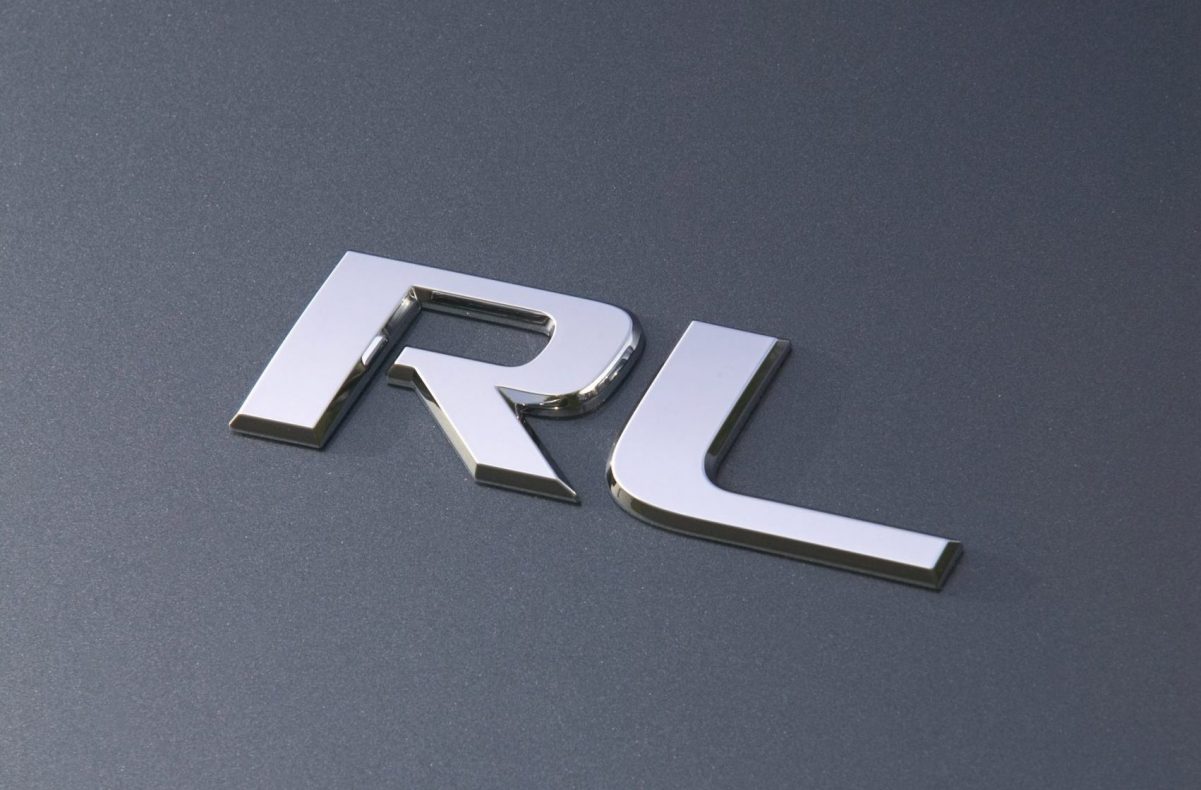
Contents
Introduction
In the race to establish premium Japanese automotive brands in the US, Honda was first with its Acura division. In 1986, Acura debuted its flagship model, the Legend, alongside a sporty hatchback, the Integra. Both sold well and established Acura as a top luxury marque in North America practically overnight.
The Legend was a truly remarkable car, deserving of its rather ambitious name. Shortly after its debut, it found a place on Car and Driver’s 10Best list three times in a row (1988-1990), and its second iteration, which first appeared in 1991, was even better. YouTube car reviewer Doug Demuro profiled the second-gen Legend in this video, calling it one of the coolest cars of the era.
The RL was born when Acura changed its model naming convention, moving to alphanumeric monikers in the mid 1990s. Thus the third-generation Legend, which first appeared in 1996, became the Acura RL — or, more specifically, the “3.5RL” since Acura wanted to call attention to the new 3.5-liter V6 engine under the hood.
While the RL was technically a new model, it built upon the essential goodness of the Legend that preceded it, featuring top-quality Honda engineering in a handsome and highly functional package, with plenty of luxury touches to make it feel special.
And those are the qualities that make the RL an interesting used car purchase today.
Model History
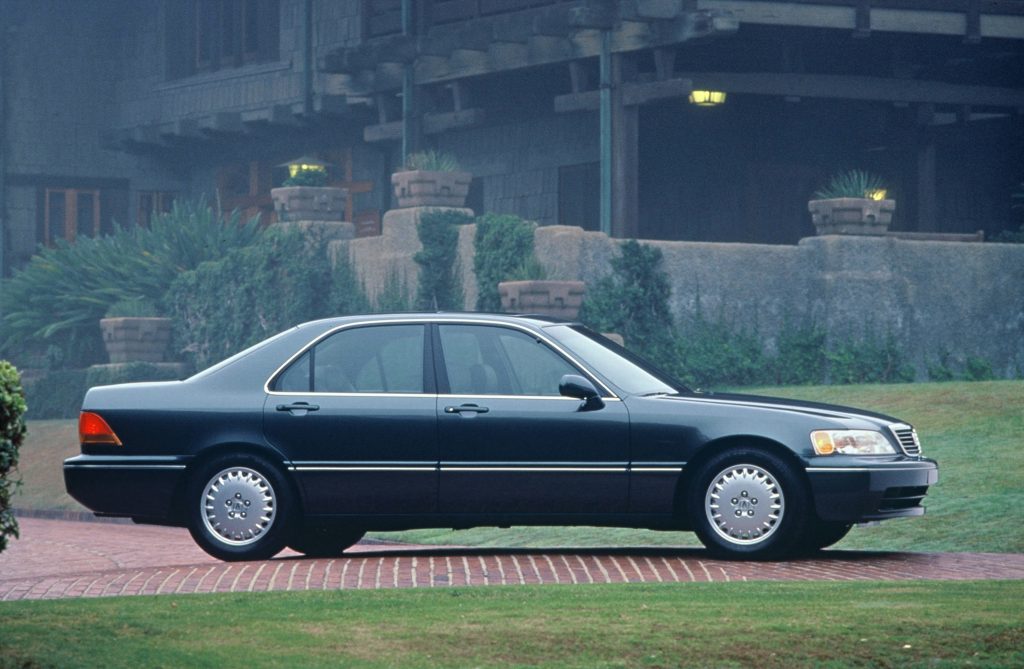
First Generation (1996-2004)
Acura launched the RL for the 1996 model year. Essentially a third-generation Legend (and known internally as the “KA9”), the sedan featured a new badge on its trunk lid: “RL,” which stood for “refined luxury.” That’s a fitting way to describe this iteration of Acura’s top-of-the-line model.
Where the outgoing Legend had clear sporting intentions — in the form of a firm ride, a rev-happy V6, and an available six-speed manual transmission — the first gen RL was decidedly more Lexus-like. That is: softer, plusher, and more refined. And that makes sense because Lexus at that time was seriously eating into Acura’s sales. Additionally, Acura wanted to steer sports sedan buyers towards their more athletic model, the TL. (For more about the Acura TL, check out our third-gen TL buyer’s guide.)
Under the Hood
Under the hood of the RL, engineers massaged the prior Legend’s V6 engine to perform more like the V8s found in competitors like the Lexus LS400 and the Mercedes-Benz E420. Though peak horsepower was actually down slightly (230 vs 210), displacement grew from 3.2 to 3.5 liters, increasing torque by ten percent to 224 lb-ft, then an all-time high for Acura. Coming at a relatively low 2800 rpm, that translated throttle inputs into more instantaneous shove.

Like the second-gen Legend’s, the RL’s engine is mounted longitudinally, rare for a front-wheel-drive car. That allowed designers to minimize the car’s front overhang, giving it a rear-drive look, while also enabling a highly stable 60/40 weight split between the front and rear wheels. Gone was the Legend’s manual transmission option; all RL buyers got Honda’s competent four-speed automatic instead.
The first-gen RL kept the outgoing Legend’s sophisticated double-wishbone suspension front and rear, but it was now tuned for a cushier ride. Acura added fancy bits such as liquid-filled trailing arm bushings and Teflon-sealed dampers to prevent unwanted noises and vibrations from intruding into the cabin. The result is a creamy smooth driving experience. Edmunds reviewers at the time explained, “The entire purpose of the 3.5RL is to deliver passengers from point A to point B with minimal fuss and intrusion from the outside world.”
Inside the Cabin
Inside the RL is where Acura’s push for more luxury is most apparent. The cabin design features wide expanses of glass for excellent outward visibility as well as a feeling of spaciousness. Rich leather abounds, complemented by genuine burl wood trim from famed Japanese woodworking firm Tendo. Designers fussed over the power-adjustable front buckets, trying numerous different spring configurations before settling on the one that best isolates occupants from bumps and vibrations. Meanwhile rear-seat passengers benefit from two additional inches of legroom compared to the outgoing Legend.
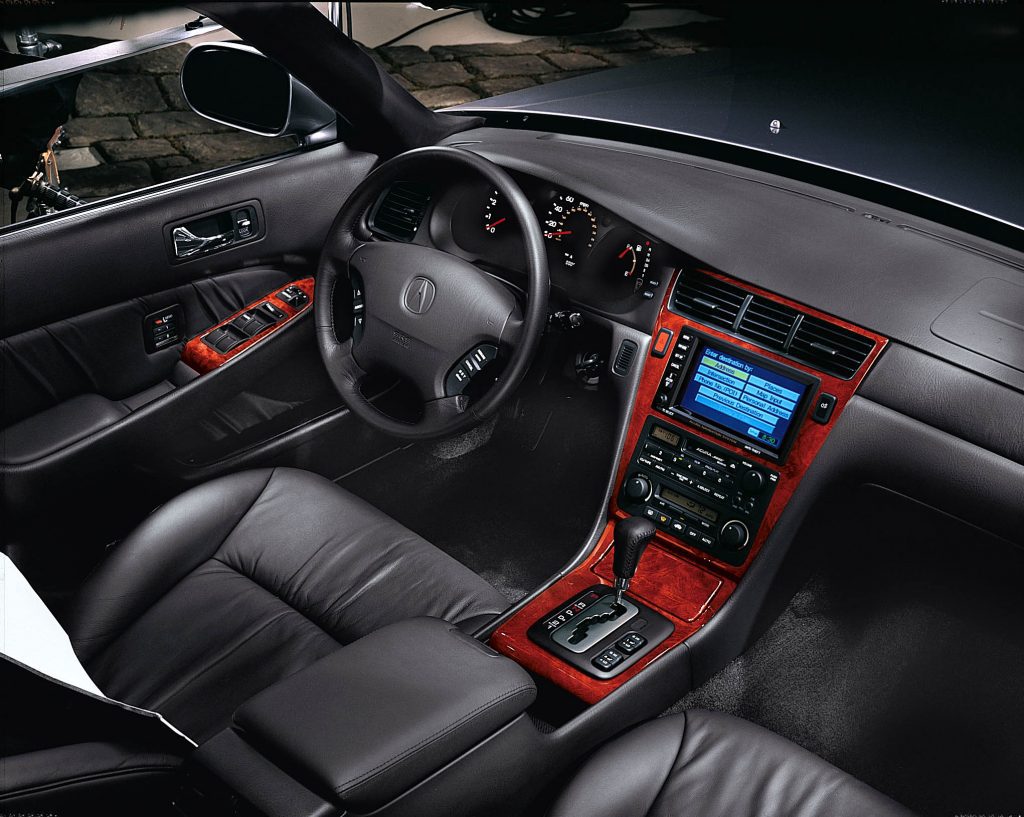
All RLs came well-equipped for the time, with automatic climate control, automatic headlights, an 8-speaker sound system, cruise control, air filtration, a moonroof, and power everything. Opting for the Premium package added heated seats and mirrors, additional wood trim, and an upgraded 225-watt Bose sound system. The RL was also one of the first vehicles to offer a GPS-enabled satellite navigation system. Though outdated now, the system — which even featured verbal navigation prompts — was revolutionary for its day.
Model Year Changes
After its 1996 debut, the first-gen Acura RL continued through the 1997 model year essentially unchanged.
For 1998, Acura revised the suspension to improve handling and also fitted new machine-finished alloy wheels. Inside the cabin, the formerly optional 8-speaker 225-watt Bose audio system became standard.
The RL underwent a mild refresh for the 1999 model year (pictured below), with restyled front and rear ends, improved body rigidity, and an updated interior, which added a new navigation system, side air bags, plus a 6-disc trunk-mounted CD player.
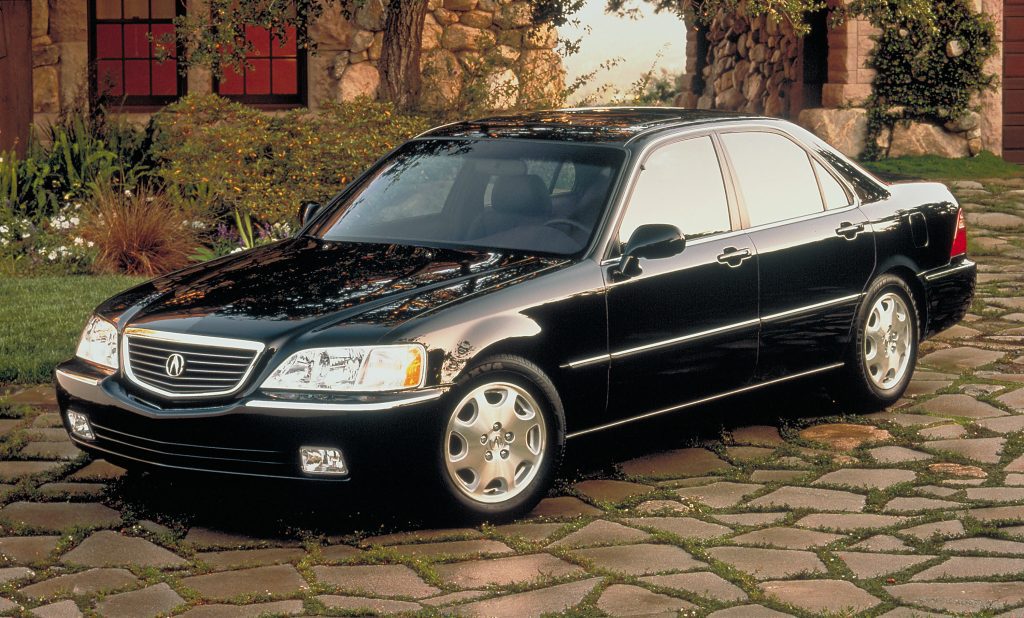
For 2000, the RL got Acura’s Vehicle Stability Assist (VSA) stability control system as standard equipment.
Acura updated the official name of the RL from the “3.5RL” to the “3.5 RL” for the 2001 model year. Bonus points for those who can spot the difference.
In 2002, a revised engine was fitted to the RL, upping output to 225 horsepower and 231 lb-ft of torque. Further improvements included a retuned suspension and added sound insulation.
The RL received some slight styling updates for the 2003 model year, including a new wheel design, taillights with clear turn signal lenses, and a choice of three interior wood trim colors.
For 2004, the first generation’s final model year, the RL got an updated navigation system with voice control as well as an improved 10-speaker stereo with a 6-disc in-dash CD change and XM satellite radio.
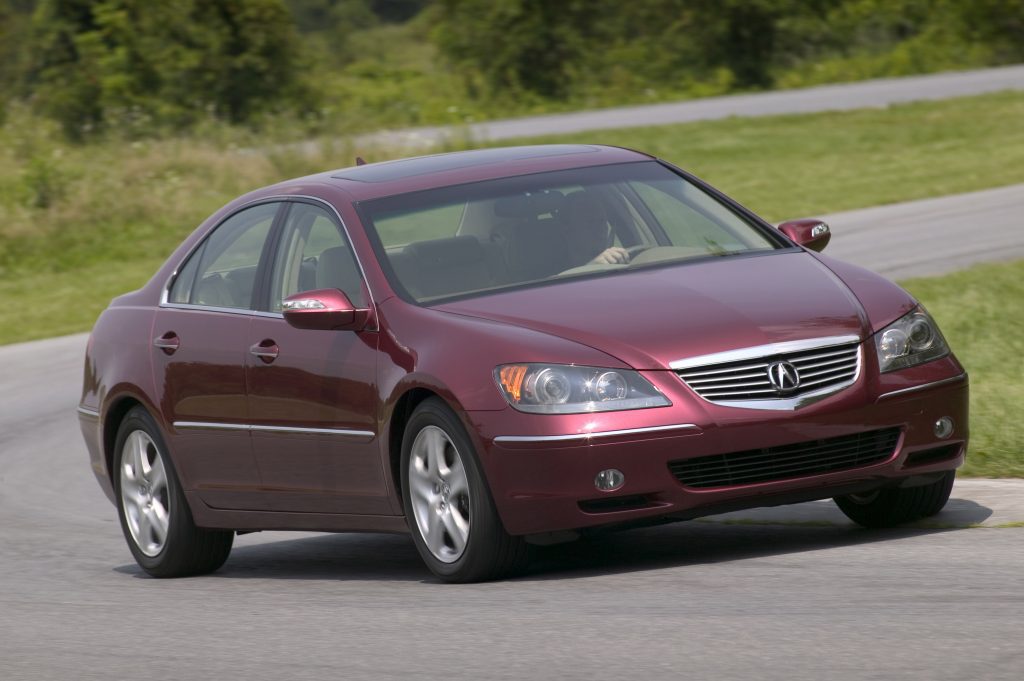
Second Generation (2005-2012)
Despite its many fine qualities, the first-gen RL got only mixed reviews from the press. They said it lacked the power offered by competitors, that its styling was bland, and that its handling was too soft. Sales were down, too, from the preceding model. Acura attempted to address all of these issues with an all-new RL (internal code “KB1”), which launched in 2005.
In typical Honda fashion, they tapped engineering to solve many of these problems, and that group came up with some rather innovative solutions. Chief among them was the second-gen RL’s new all-wheel drive setup. Marketed as Super Handling All-Wheel Drive (SH-AWD), the system deployed a trick rear differential capable of sending as much as 70% of the power to the rear wheels. It could also vary the power from left to right by as much as 100%, depending on road conditions and driving dynamics.
The SH-AWD system helped to transform the RL from a solid luxury cruiser into an agile sports sedan. In its review at the time, MotorWeek offered high praise for the RL’s newfound athleticism: “Without being reckless, we just couldn’t force the RL out of its smoother cornering lines. The words safe, secure, and solid played over and over again around every bend.”
That nimbleness was reflected in the RL’s new shape, as well. It dropped the staid, slab-sided look in favor of dramatic new curves and angles. Instead of getting bigger, like most other luxury flagships at the time, the second-gen RL shrank by about three inches in length (without losing any interior space). Its wheels were also pushed slightly wider, giving it a more aggressive stance. Engineers utilized high-tech materials like aluminum alloy and magnesium throughout its structure to add strength and keep weight to a minimum.
Aided by flush side glass as well as a smooth underbody, the sleek new design achieved a low 0.29 drag coefficient.

Under the Hood
Acura fitted an all-new engine to the second-gen RL. While it still displaced 3.5 liters in a V6 configuration, the new mill now benefited from Honda’s variable valve timing technology (VTEC). This enabled a notable jump in power, from 225 horsepower in the outgoing RL to 300 hp in the new one. Torque rose significantly, too, from 231 to 260 lb-ft. (Note that for 2006 these figures were revised downward to 290 hp and 256 lb-ft due to a change in SAE testing procedures.)
Gone, too, was the old-school four-speed automatic. In its place, a new five-speed unit was fitted. It featured paddle shifters mounted on the steering wheel, an unusual feature at the time. Routing power to all four wheels, the new engine and gearbox combo could hustle the RL to 60 mph in a hair over seven seconds, which was pretty quick for a roomy sedan back then. It also delivered reasonable economy for a big car: 16 mpg in the city and 24 mpg on the highway, according the the EPA.
For folks who needed an even sportier RL, a dealer-installed A-Spec performance package was available from 2005 to 2008. It offered 18-inch alloy wheels (up one inch from the stock 17s), beefier springs and shocks, plus a body kit, which tarted up the RL with a front air dam, side skirts, a rear diffuser, and a small spoiler on the deck lid of the trunk.
To be clear, the second-gen RL still didn’t deliver the same levels of thrust available in some competitors, many of which employed V8s. Still, it managed a second-place spot in a Car and Driver comparison test at the time thanks to its all-around goodness. C&D called it “an exceedingly well-integrated vehicle” with an engine that delivers “a stirring six-cylinder snarl” and an interior that is “one of the tidiest layouts in the group.”

Inside the Cabin
As with the rest of the car, Acura didn’t hold back when it came to updating the second-gen RL’s interior. Its slick new design still looks fresh today, and the quality of the materials remained top notch. Of particular note are the wide, comfortable seats, which also benefit from additional headroom vs the first-gen model, and the excellent Bose audio system, which offers noise-cancelation technology to reduce ambient noise and clarify the music. As an Edmunds reviewer put it, it sounds “so superb that you’d swear Gladys Knight was riding shotgun with the Pips crammed in back.”
Like the prior version, the second-gen RL came very well equipped, with heated leather seats, navigation, a sunroof, adaptive HID headlights, keyless entry and ignition, and front, side, and side-curtain airbags all standard. The only available option (other than the A-Spec kit noted above) was the Tech package, which added radar-based adaptive cruise control along with a related collision-mitigation braking system (CMBS), which applies the brakes automatically if an impending crash is detected. Both features are rare in vehicles from this era.
Safety was also a second-gen RL strength. It received primarily “Good” ratings (the highest score) in its evaluation by the Insurance Institute for Highway Safety (IIHS), while the National Highway Traffic Safety Administration (NHTSA) gave it five-out-of-five stars in all categories.
Model Year Changes
The second-gen RL debuted for the 2005 model year.
For 2006, Acura added the first version of its Tech package, bundling radar-based adaptive cruise control with a collision-mitigation braking system (CMBS) and Michelin PAX run-flat tires.
For 2007, Acura split the Tech package into two versions. The basic Tech package added navigation (formerly standard) and larger 18-inch wheels, while the Tech package with CMBS and PAX also included, you guessed it, the optional collision-mitigation braking system and Michelin run-flat tires.
For 2008, the RL continued without any notable changes.
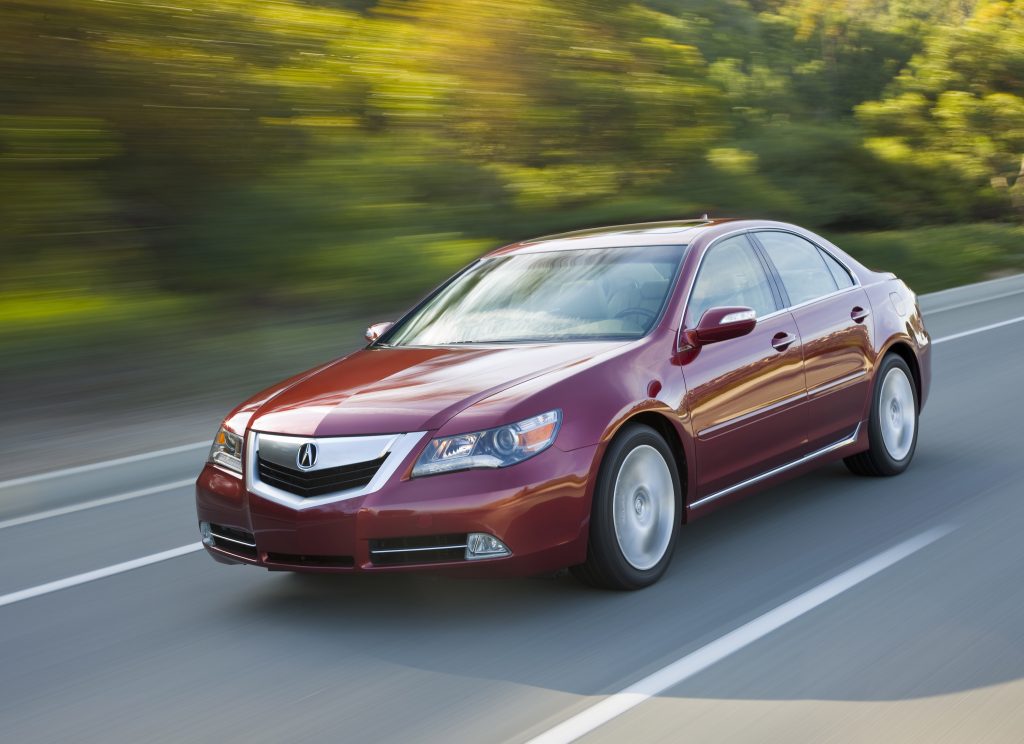
Acura thoroughly refreshed the second-gen RL for the 2009 model year — enough that they also gave it a new internal model code, “KB2.” The changes included a bold new grille (pictured above), a slightly larger and more powerful V6 (up to 3.7 liters and 300 horsepower, with the first-ever use of VTEC on the exhaust valves), standard 18-inch wheels, and a revised suspension for even sportier handling.
For 2010, a USB port was integrated into the audio system.
For 2011, a minor model refresh gave the RL yet another new grille (slightly toned down from the 2009 version) plus a new six-speed automatic transmission, available parking sensors, and additional sound insulation. Also, the wheels now incorporated Helmholtz resonators to tame road noise even further.
There were no significant changes for 2012, the second-gen RL’s final year. It was replaced the following year by an all-new model, the RLX.
Problem Areas
As you might expect from a Honda product, the RL enjoys a strong reputation for reliability. Many examples make it to 250,000+ miles with little more than routine maintenance. Still, there are a few problem areas to be aware of.

Transmission Issues
Quite a few Honda vehicles from the early 2000s have problems with their automatic transmissions (see this related thread on the Edmunds forums), and the RL is not immune. Owners report that the key to a long transmission life in the RL is frequent fluid changes with Honda-spec transmission fluid. Make sure to look for evidence of that in the service records of any used RL you’re considering.
Drivetrain Noises
During your test drives, listen for whining or fluttering sounds coming from the transmission, especially around 30-50 mph under light throttle. According to some RL owners on Acurazine, this may be related to a failing torque converter, which costs about $2000 to replace. Others report that a simple transmission fluid change can sometimes solve the problem.
Another somewhat common ailment for RLs, especially from early in the second generation, is a slight driveshaft whine, which may be accompanied by a whirring sound from the rear differential. Acura recognized this problem for 2005-2006 models in a technical service bulletin, which calls for replacing the driveshaft’s center bearing. If you’re considering a used RL from one of those two years, be sure to check whether that work has been carried out. See this related thread on Acurazine for more details.
Electrical Issues
RL owners also report occasional electrical gremlins with their cars. This can include problems such as flickering headlights, an illuminated AFS (active front headlight) warning light, failing electric door handles (for cars with keyless entry), and air conditioning woes.
Car and Driver documented a number of these issues with their long-term test car, a 2005 RL, which they called a “great car if you can get it away from the dealer for a while.” To be fair, the problems they faced seem to result at least in part from the fact that their car was from early in the production run for that generation. Other model years (especially 2007 and later) appear to have far fewer of these issues.
If you’re shopping for a used RL, we’d suggest steering clear of any examples that exhibit electrical problems, as they can be difficult to resolve completely.
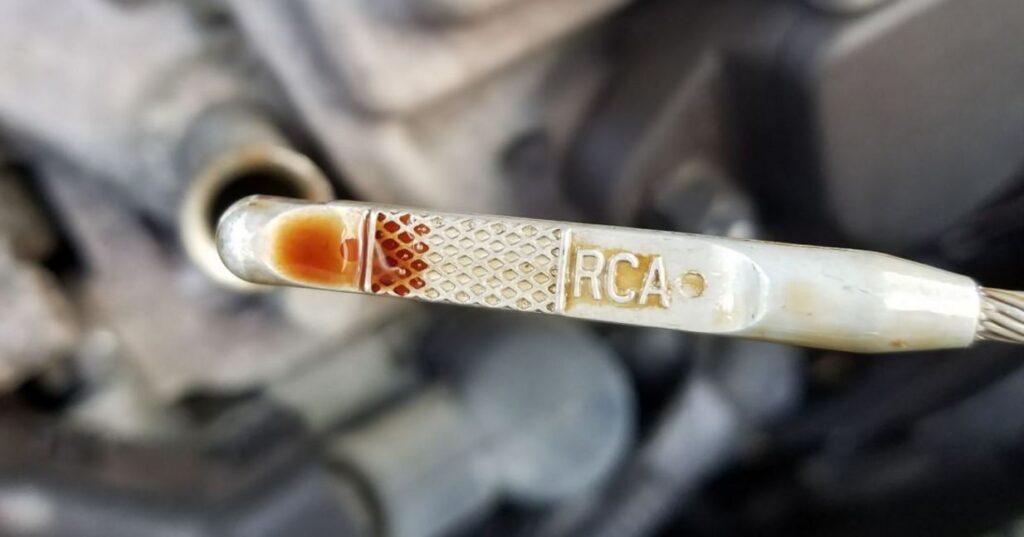
Oil Consumption
The larger 3.7-liter V6 (engine code “J37”) that Acura used for the RL’s final model years (2009-2012) is prone to excessive oil consumption. Some have reported their J37 engines using as much as one quart of oil for every 1000 miles driven. Not every car is affected, but enough have been that owners filed a class action lawsuit against the automaker, which has been settled out of court.
According to CarComplaints.com, the settlement means that owners who verify an oil consumption problem with the dealer can qualify for a fix under an extended powertrain warranty, covering eight years or 125,000 miles from the car’s initial in-service date and mileage.
Michelin PAX System
When it comes time to replace the tires, owners of Acura RLs with the optional Michelin PAX run-flat tires can be in for a nasty surprise. The tires are no longer available. Worse, it’s not possible simply to fit a different type of tire because the wheels on PAX-equipped cars aren’t a standard size. The wheels also must be swapped out, too.
Fortunately, most RLs with the PAX system have long since ditched it in favor of non-PAX wheels and tires. But it’s something to look out for during your search.
Pre-Purchase Inspection
Finally, before you spend thousands on a used RL, we highly recommend hiring an Acura specialist to evaluate it. For about $250, they’ll provide you with a thorough inspection of the entire car. This can reveal potentially deal-breaking issues, such as hidden accident damage or excessive engine wear, or minor things that you can use as bargaining points, like worn brake pads or aging tires. Either way, it’s easily worth the money to complete a professional inspection prior to finalizing any used car purchase.
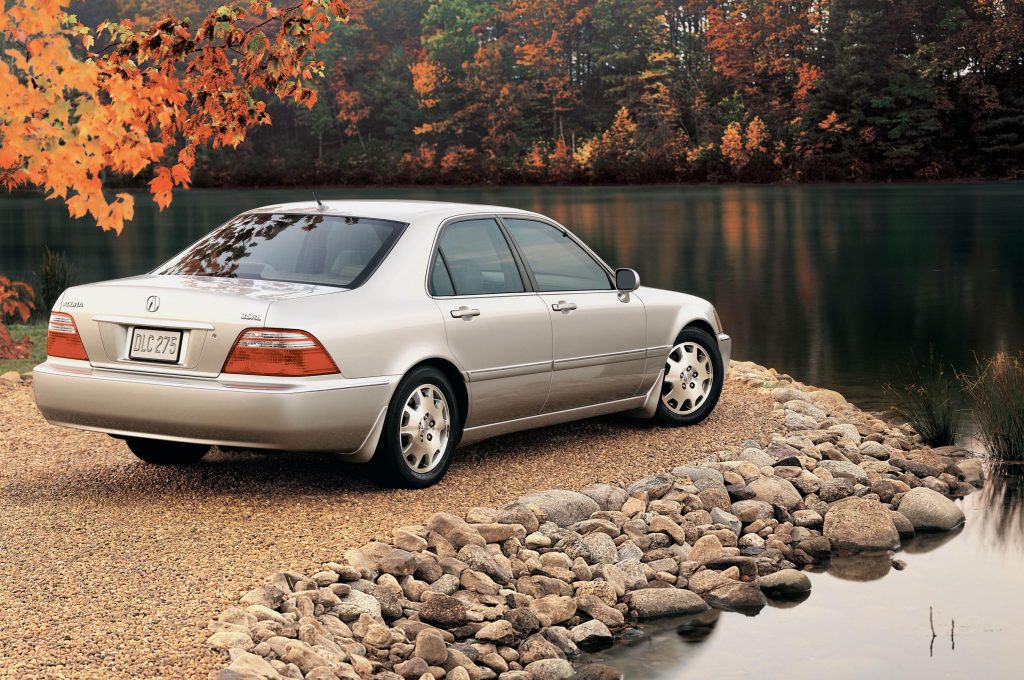
What are the Best Years?
The Acura RL story has two distinct chapters. Where the first-gen RL is a classic 1990s luxury car — understated, richly-appointed, and comfortable — the second-gen RL, with its innovative SH-AWD system and modern amenities, is much more of a high-tech marvel. Both are reliable, well-made cars, as you’d expect from Honda. Which one you buy really comes down to a matter of taste.
Fortunately, after more than a decade of depreciation, either generation can be had for very little money these days. Your main goal when seeking out a used RL should be to find one that’s enjoyed a long and well-documented service history carried out by Acura specialists.
In a recent search on Autotrader, we found about 100 examples for sale nationwide, split about 25 to 75 between first and second generations.
Prices for first-gen RLs range from around $2500 for solid examples with over 200,000 miles to around $8500 for cherry ones with fewer than 100,000 miles on the clock. It’s possible to pay even more for a rare garage queen. However, these aren’t collector cars, so we wouldn’t advise it.
The main problem with buying a first-gen RL is finding one that’s still in excellent shape. With most of them now at least 20 years old, the vast majority have been used up. Still, if you’re patient, you should be able to find one that’s been loved. If you’re having trouble, try widening your search radius and considering cars that are out of state.
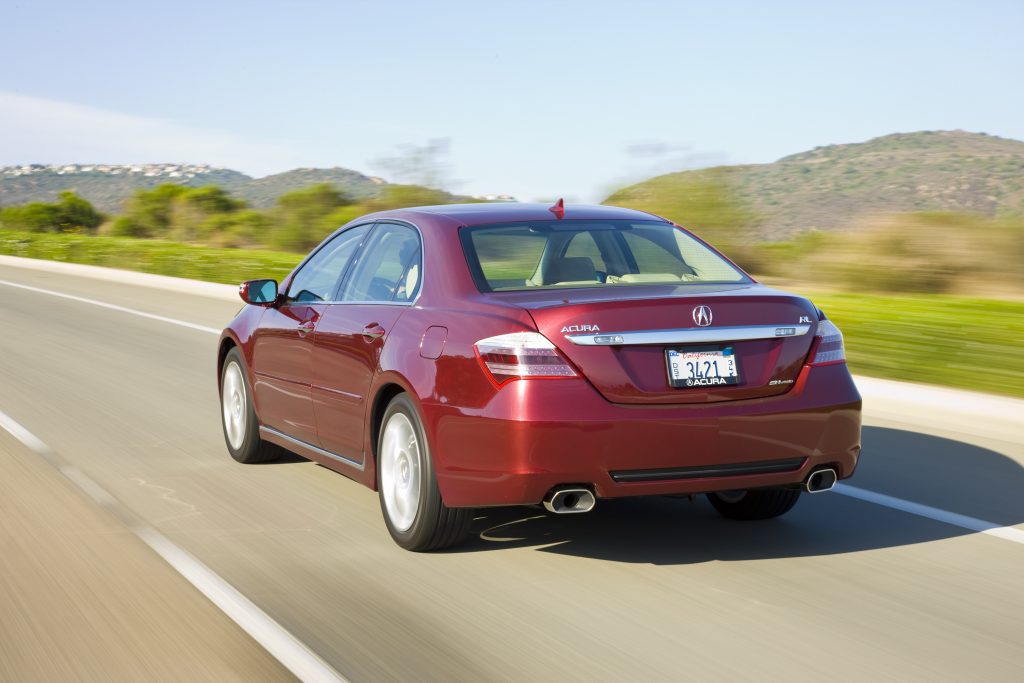
Prices for second-gen RLs range from around $5000 for higher-mileage specimens (over 150k) to around $15,000 for later model years with unusually low miles (50k or less). That’s roughly twice as much as the prior generation, but it’s still quite reasonable considering the upgrades that come along with it, particularly the second-gen’s excellent SH-AWD system.
That said, we’re partial to the simplicity of the original. While dismissed as too conservative during its day, the first-gen RL’s long and lean lines strike quite a classic pose these days. It’s reminiscent of a vintage Mercedes-Benz S-Class but with far more reasonable running costs. No doubt that’s what its designers originally had in mind — though, most likely, they didn’t envision it taking two decades to get there.
Photos courtesy of Acura and Wikimedia Commons